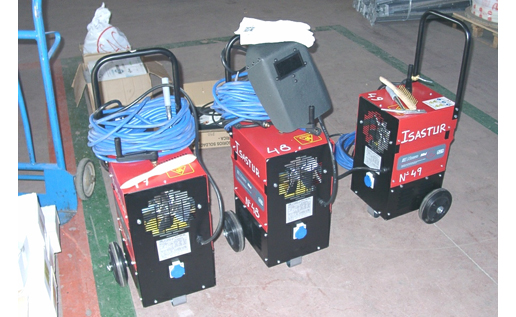Tools and Equipment
6. Hazards resulting from the use of electric arc welding and oxy-cutting equipement
6.1. Usual hazards
Projected particles
These may be due to:
- Non-incandescent particles given off during the operation of cleaning off the slag in the welding process.
- Incandescent particles given off during the operation of cutting or welding.
Preventive measures:
- Control sparks and particles at their origin using fireproof screens, canvases or coverings to isolate the workstation and protect third parties against this hazard.
Thermal Contacts:
- From Contact of all or part of the body with high temperature objects, parts, etc., such as hot parts or drops of molten material.
- Moreover, in oxy-cutting, the hazard of freezing due to Contact with the liquefied gas and burns due to Contact with gas at a high temperature must also be added.
Preventive measures:
- Before starting work, the area is to be delimited on the vertical of the workstation where sparks and incandescent material may fall.
- Prior to commencing work, check that there is no-one in the surroundings of the vertical of the workstation. Fireproof screens, canvases or covers may be used indistinctly to isolate the workstation and protect third parties.
- Hot parts are to be marked as such to prevent them from being touched inadvertently.
- Recently welded or recently cut parts are not to be touched, as they may be at a sufficiently high temperature to produce serious burns.
Non-ionizing radiation:
- Possible injuries to the eyes and skin may be produced due to exposure to the visible, infrared and ultraviolet radiation produced during these processes.
Preventive measures:
- Isolate the workstation by means of fixed or mobile screens, if possible, to avoid risks to third parties.
- Assistants on these jobs are to use a protective screen and the entire team is to work in a coordinated manner.
- In electric arc welding, do not look at the voltaic arc directly (“welder’s flash” hazard). The luminous intensity may provoke serious injuries to the eyes.
Exposure to toxic or asphyxiating substances
Metal gases and fumes may be generated by volatilization and oxidation of the metallic components of the material being worked on and of its possible finishes, either a metallic finish (galvanizing, chroming, nickel-plating, etc.) or a paint which, on burning, generates oxides of the metallic compounds it contains.
The gases produced during these operations may produce injuries or disorders in those persons exposed to them.
These gases may be:
- Gases due to the base material and to the filler material.
- Gases produced by the finishes on metals.
- Gases produced by the temperature of the arc and the atmosphere in arc-welding processes. In the case of oxy-cutting processes, gases produced by the temperature of the arc and the atmosphere.
- Gases used in oxy-cutting.
For a particular amount of pollutant generated in these processes, the percentage inhaled by the worker basically depends on 3 factors that must be taken into consideration to establish preventive measures:
- The worker’s position with respect to the welding point.
- The distance from the point of emission.
- The extraction of pollutants.
Preventive measures:
- As preventive measures to employ whenever possible, the pollutants are to be evacuated either using a localised extraction system or by means of general ventilation.
- These operations should preferably be carried out in well ventilated premises.
- If the work is carried out in the workshop, this is to have direct, continuous ventilation.
- Special care is to be taken when welding or cutting material that is painted or which has a metal finish (Pb, Cd, Cr, etc.).
- In confined settings, a localised extraction system is to be installed or autonomous breathing equipment is to be used and another worker is to remain outside at all times, prepared to intervene if needs be.





